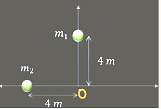An electric dipole consists of two opposite charges, each of magnitude $1.0\, \mu C$ separated by a distance of $2.0 \, cm$. The dipole is placed in an external field of $10^5 \, NC^{-1}$. The maximum torque on the dipole is
- $ \ce{ 0.2 \times 10^{-3} \, N m}$
- $ \ce{ 1 \times 10^{-3} \, N m}$
- $ \ce{ 2 \times 10^{-3} \, N m}$
- $ \ce{ 4 \times 10^{-3} \, N m}$
The Correct Option is D
Solution and Explanation
(i) $Z_{\max }=p E=\left(2 \times 10^{-8}\right)\left(10 \times 10^{5}\right)=2 \times 10^{-3} N - m$
(ii) Net work done in turning the dipole from $0^{0}$ to $180^{\circ}$
i.e $W =\int_{0^{\circ}}^{180^{\circ}} \overline{ r } d \theta=\int_{0^{\circ}}^{180^{\circ}} pE \sin \theta d \theta$
$$
\begin{array}{l}
= pE [-\cos \theta]_{0^{0}}^{180^{\circ}} \\
=- pE \left(\cos 180^{\circ}-\cos 0^{0}\right) \\
=2 pE \\
=2 \times\left(2 \times 10^{-8}\right)\left(1 \times 10^{5}\right) J \\
=4 \times 10^{-3} J
\end{array}
$$
Top Questions on Electric charges and fields
- Two particles each of mass \(2\) kg are places as shown in \(x→ y\) plane. If the distance of centre of mass from origin is \(\frac{4\sqrt 2}{x}\) find \(x\) :

- JEE Main - 2024
- Physics
- Electric charges and fields
- A uniform electric field of $10 N / C$ is created between two parallel charged plates (as shown in figure) An electron enters the field symmetrically between the plates with a kinetic energy $05 eV$ The length of each plate is $10 cm$ The angle $(\theta)$ of deviation of the path of electron as it comes out of the field is ___ (in degree)

- JEE Main - 2023
- Physics
- Electric charges and fields
- Electric field in a certain region is given by $\overrightarrow{ E }=\left(\frac{ A }{x^2} \hat{i}+\frac{ B }{y^3} \hat{j}\right)$ The $SI$ unit of $A$ and $B$ are :
- JEE Main - 2023
- Physics
- Electric charges and fields
Given below are two statements : One is labelled as Assertion $A$ and the other is labelled as Reason R
Assertion A : Two metallic spheres are charged to the same potential One of them is hollow and another is solid, and both have the same radii Solid sphere will have lower charge than the hollow one
Reason R : Capacitance of metallic spheres depend on the radii of spheres
In the light of the above statements, choose the correct answer from the options given belows- JEE Main - 2023
- Physics
- Electric charges and fields
- A 10 μC charge is divided into two equal parts and kept at 1 cm distance. Find repulsion between charges?
- JEE Main - 2023
- Physics
- Electric charges and fields
Questions Asked in COMEDK UGET exam
- A $2\,kg$ mass lying on a table is displaced in the horizontal direction through $50\,cm$. The work done by the normal reaction will be
- COMEDK UGET - 2015
- work, energy and power
- The numbers of $ {H^+}$ ions present in 1 mL of a solution whose pH is 13
- COMEDK UGET - 2015
- Equilibrium
- A mixture of methylamine and dimethylamine is given to you. The reagents used to separate the components of the mixture are
- $\cot^{-1} (21) + \cot^{-1} (13) + \cot^{-1} (-8) =$
- COMEDK UGET - 2015
- Inverse Trigonometric Functions
- Pick the incorrect statement among those given below.
- COMEDK UGET - 2015
- Chemical bonding and molecular structure
Concepts Used:
Electric charges and field
What is Electric Charge
It is the property of subatomic particles that experiences a force when put in an electric and magnetic field.
What is Electric Field
It is a property associated with each point in space when charge is present in any form. The magnitude and direction of the electric field are expressed by E, called electric field strength or electric field intensity.
Electric charges are of two types: Positive and Negative. It is commonly carried by charge carriers protons and electrons.
Properties of Electric Charge
Various properties of charge include the following :-
- Additivity of Electric Charge
- Conservation of Electric Charge
- Quantization of Electric Charge
Types of electric charge
Two kinds of electric charges are there :-
Negative Charge - When an object has a negative charge it means that it has more electrons than protons.
Positive Charge - When an object has a positive charge it means that it has more protons than electrons.
When there is an identical number of positive and negative charges, the negative and positive charges would cancel out each other and the object would become neutral.



